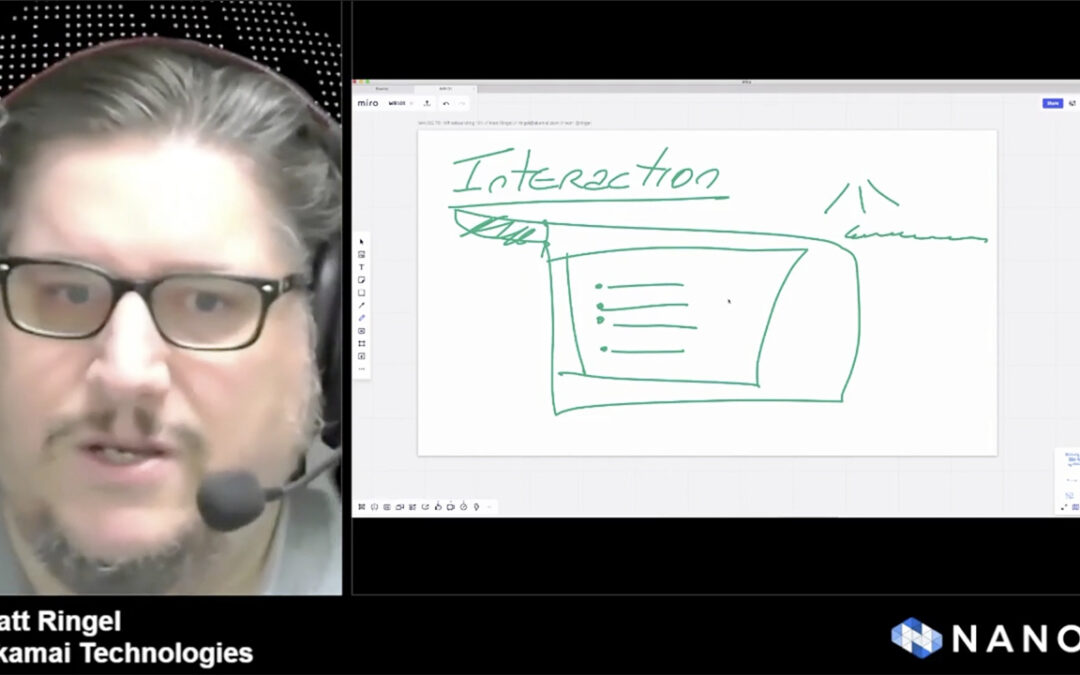by Mandie Sellars, Director of Marketing and Communications
During this time of extended closures and remote work, we find ourselves having to attend (and often endure) countless Zooms, webinars, and other virtual gatherings. We found Matt Ringel’s talk about whiteboarding from NANOG 79 especially relevant as audiences become more overloaded, distracted, and disengaged from being stuck at home, working remotely, for months on end. Trends show many businesses may never fully reopen their offices, so being able to put together a thoughtful, engaging, well-planned virtual presentation is becoming an even more important skill to have.
Ringel’s talk begins with a look at how to use narratives to make your presentations more interesting. Even the most technical discussions can incorporate storytelling, and will be all the better for it. Our brains are wired to stay engaged with a narrative and we are automatically drawn to wondering “what happens next.” Presenting real-life stories, or even invented ones, really help draw in potentially tuned-out, distracted audience members.
As Marketing Director at NetActuate, I have definitely found that the inclusion of narrative case studies and anonymized deployment examples improved our engagement with potential customers. Storytelling has also helped us break down otherwise difficult, technical content into more understandable and relatable materials, making our sales and marketing efforts more effective.
Ringel moves on to discuss ways to frame your talk, ensuring the topic of your presentation isn’t too abstract or too “in the weeds.” It also helps guide how to include just the right amount of material to cover given your time constraints. Following Ringel’s framing advice will help ensure your audience isn’t bored because everything is too abstract for “hand wavey” OR because you have veered off into overly-specific discussion topics only a handful of audience members will understand.
After framing, Ringel’s next tip was to include pictures, informational graphics, or other non-text visual aids. Even the most simple graphic (his example was a quadrant chart) can be used to help convey information much more quickly and effectively than bullet point lists or text walls.
Ringel’s advice is spot on here – I spend a lot of time ensuring our presentations at NetActuate include rich, visual content even for the most complex deployments and networking concepts (examples include our BGP anycast use cases). When we include these types of graphics, we see better and faster comprehension during virtual meetings. They have also helped potential customers advocate on our behalf when they need to build consensus or get approval to proceed with an order.
The hour-long talk included other invaluable pieces of advice, from agenda-setting to ensuring your presentation has opportunities for audience interaction built in, even if it is a simple opportunity for attendees to “raise their hand” on Zoom. He also gave savvy pointers on dealing with problem audience members, from bullies to the often-heard NAGMOAC (“Not a question, more of a comment…”), who are prone to hijacking meetings with their own pontificating. Another helpful reminder to presenters was to never make up answers to questions they don’t know. It is easy to want to be seen as an expert when posed with a difficult question, but giving wrong or overly vague advice, rather than simply saying “I’m not sure,” can do more harm than good in the long run.
Overall, Ringel set out some very doable, but important ways you can improve your presentations, meetings, sales calls, or other virtual group events. His talk is all the more timely as virtual communication is quickly becoming the norm. We encourage you to watch the whole presentation when you have time. We are excited as the all-virtual NANOG 80 draws closer to see what great talks they have in store.
